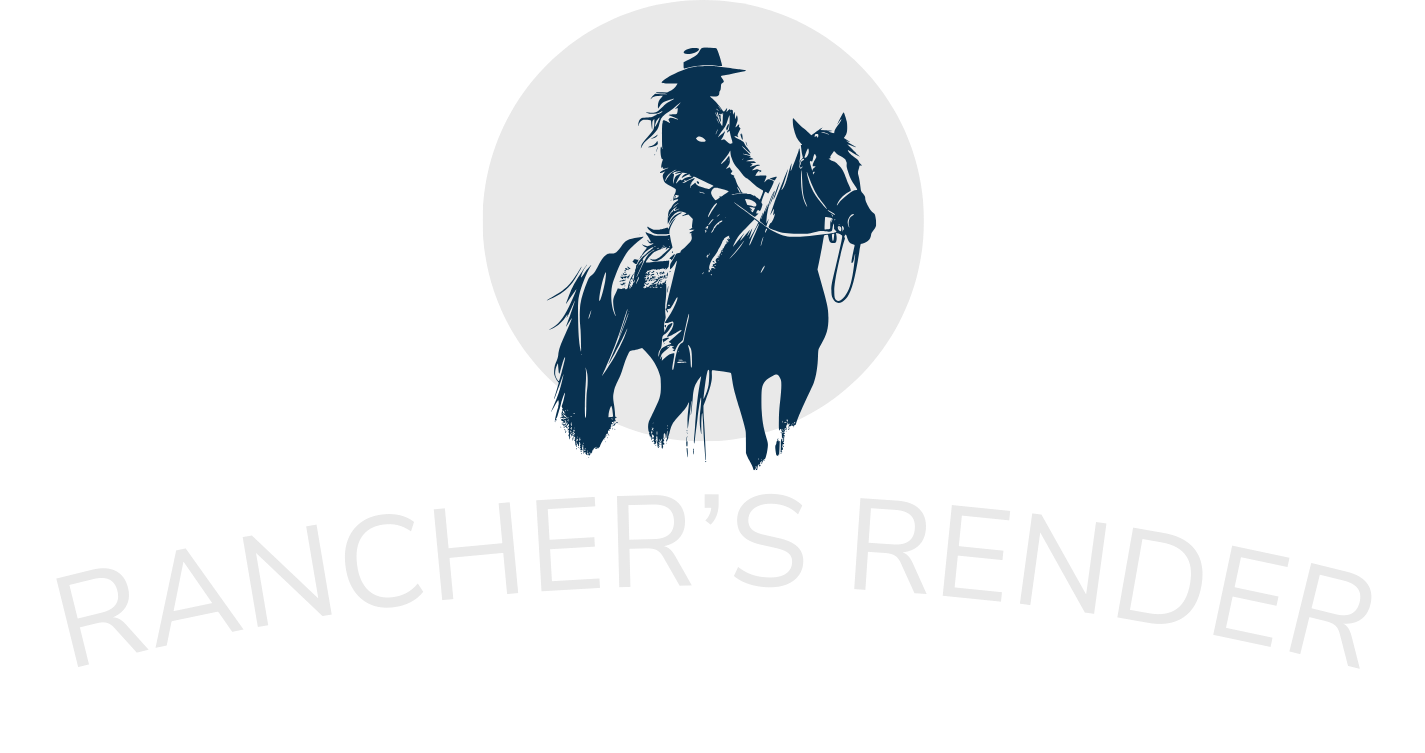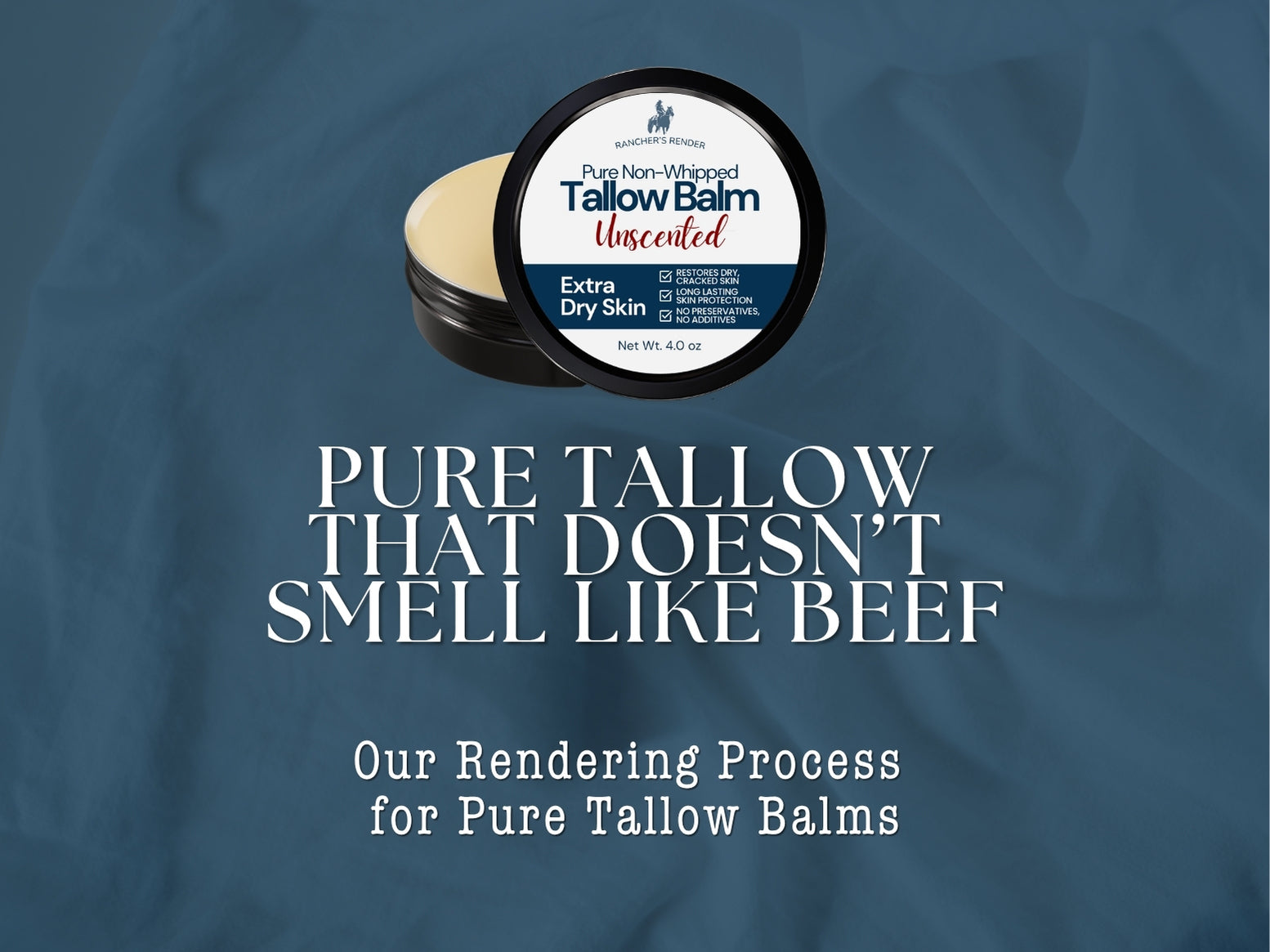How to Remove the Smell of Beef Tallow During the Rendering Process
One of the most common concerns we hear from customers exploring tallow skincare is simple: "Does beef tallow smell?" The honest answer is that it depends entirely on how the tallow was rendered and what type of fat was used. High-quality tallow from properly rendered suet should have minimal scent—often described as neutral or butter-like—while poorly processed tallow can carry a distinct beef odor that makes it unpleasant for skincare use.
At Rancher's Render, we've spent years perfecting our rendering process to produce tallow that's nearly odorless while maintaining all its beneficial properties. Whether you're considering making your own tallow or simply want to understand what separates quality products from inferior ones, this guide will explain the science behind tallow odor and proven methods to minimize or eliminate unwanted smells.
What Does Beef Tallow Smell Like?
Pure, properly rendered beef tallow has a mild scent that most people describe as neutral or slightly butter-like. Does beef tallow smell like beef? It shouldn't. When tallow retains a strong beef odor, it indicates either poor-quality source material or inadequate processing techniques.
The confusion often stems from the type of fat used. Some commercial producers and DIY enthusiasts use trim fat—the fatty pieces cut from steaks and roasts that contain blood, meat fibers, and connective tissue. When rendered, these impurities create the characteristic "beefy" smell that people associate with tallow.
In contrast, suet—the pure fat surrounding the kidneys and organs—contains virtually no meat or blood. When properly rendered, suet produces white, nearly odorless tallow that's ideal for skincare applications. This is why we exclusively use kidney suet from our grass-fed cattle at Ranchers Render.
Does Beef Tallow Smell on Skin?
High-quality tallow should not leave a noticeable smell on your skin. If your tallow balm has a lingering beef odor after application, it likely contains impurities from poor rendering or low-grade source material. Properly processed tallow absorbs quickly into skin and any minimal scent dissipates within minutes.
Why Does Beef Tallow Smell?
Understanding the science behind tallow odor helps explain why some products smell while others don't:
Source Material Quality
The biggest factor in tallow scent is the quality of raw fat used:
- Trim fat: Contains meat, blood, and connective tissue that create strong odors when heated
- Mixed fat sources: Combining different grades of fat produces inconsistent results
- Pure Suet: Pure fat with minimal impurities, resulting in neutral-scented tallow
- Age and handling: Old or improperly stored fat develops rancidity that persists through rendering
Read our post Suet vs. Trim Fat and watch the 2 min video with Stefan explaining the difference.
Rendering Temperature
Temperature control during rendering is critical. High heat causes several problems:
- Scorches proteins and creates burnt odors
- Breaks down beneficial compounds
- Caramelizes any meat residue, intensifying beef smells
- Reduces the quality of final product
Professional rendering maintains temperatures between 130-140°F to preserve quality while removing moisture and impurities.
Processing Methods
The rendering technique significantly impacts odor:
- Dry rendering: Direct heat contact can create stronger odors if not carefully controlled
- Wet rendering: Uses water as a heat buffer and helps remove impurities
- Filtration: Multiple filtration steps remove particles that could decompose and create odors
How to Remove Beef Tallow Smell
Several proven methods can reduce or eliminate unwanted odors from tallow:
Wet Rendering Method
Wet rendering is the most effective technique for producing odorless tallow:
- Cut suet into small, uniform pieces
- Place fat in heavy-bottomed pot with enough water to cover
- Add 1 teaspoon salt per pound of fat
- Heat on lowest setting until fat fully melts (6-8 hours)
- Strain liquid through fine mesh or cheesecloth
- Cool until fat solidifies on top of water
- Remove solidified tallow and scrape off any brown residue
- Repeat process with fresh water for extra purity
The water acts as a heat buffer preventing scorching while drawing out impurities. Salt helps extract proteins and neutralize odor compounds.
Baking Soda Deodorization
For additional odor removal, baking soda can neutralize acidic compounds:
- Add ¼ teaspoon baking soda per cup of melted tallow
- Include small amount of hot water
- Stir gently and simmer briefly
- Allow to cool and separate
- Remove solidified tallow and discard water layer
Baking soda neutralizes free fatty acids that contribute to off-odors.
Multiple Filtration
Professional-grade filtering removes microscopic particles:
- Use progressively finer filters
- Filter while tallow is liquid but not hot
- Consider coffee filters for final filtration
- Filter multiple times if necessary
Professional vs. DIY Rendering
DIY Challenges
Home rendering presents several obstacles:
- Difficulty maintaining consistent low temperatures
- Limited access to professional filtration equipment
- Challenges sourcing high-quality suet
- Time-intensive process requiring constant monitoring
- Risk of contamination without proper equipment
Professional Advantages
Commercial rendering facilities offer significant benefits:
- Precise temperature control systems
- Multiple-stage filtration processes
- Quality testing for purity and safety
- Consistent results across batches
- USDA certification and regulatory compliance
At Ranchers Render, our triple-filtration process and USDA-certified facility ensure consistently pure, odorless tallow in every batch.
Curious about our rendering process?
Learn more about our quality standards and whipped tallow formulation →
Storage and Shelf Life
Proper storage maintains tallow quality and prevents odor development:
Moisture Removal
Complete water removal is essential:
- Re-melt rendered tallow without water
- Heat until no bubbling occurs (indicates water evaporation)
- Store only when completely dry
Storage Conditions
Optimal storage prevents rancidity:
- Cool, dark environment
- Airtight containers
- Protection from light and heat
- Clean utensils for handling
Properly stored tallow remains stable for months at room temperature or years when refrigerated.
Quality Indicators
High-quality tallow exhibits specific characteristics:
Visual Appearance
- Pure white color when solid
- Clear when melted
- Smooth, uniform texture
- No visible particles or discoloration
Scent Profile
- Neutral to very mild aroma
- No beef or meat odors
- Fresh, clean scent
- No rancid or off-odors
Performance Characteristics
- Absorbs readily into skin
- No greasy residue
- Consistent texture across batches
- Stable shelf life
Common Mistakes to Avoid
Several errors can compromise tallow quality:
Using Poor-Quality Fat
- Choosing trim fat over suet (learn more)
- Using old or rancid starting material
- Mixing different fat grades
- Insufficient cleaning of raw fat
Processing Errors
- Excessive heat during rendering
- Inadequate filtration
- Insufficient moisture removal
- Contamination during handling
Storage Problems
- Exposure to light and heat
- Inadequate container sealing
- Contamination from dirty utensils
- Storing while moisture remains
The Ranchers Render Difference
Our commitment to quality begins with our grass-fed cattle and extends through every step of processing:
Source Material
- Exclusively kidney suet from our own cattle
- Grass-fed, grass-finished for optimal fatty acid profile
- Never treated with antibiotics or hormones
- Processed same-day for maximum freshness
Processing Standards
- USDA-certified facility
- Precise temperature control
- Triple-filtration system
- Water activity testing for shelf stability
- Batch testing for quality assurance
Quality Results
Our process produces tallow that consistently meets the highest standards:
- Virtually odorless with neutral scent
- Pure white appearance
- Smooth, consistent texture
- Extended shelf life without preservatives
- Superior skin compatibility
Experience the difference quality makes
Try our Pure Grass-Fed Beef Tallow Balm - completely odorless for sensitive skin →
Conclusion
The question "does beef tallow smell?" doesn't have a simple yes or no answer. Poor-quality tallow from trim fat or inadequate processing will definitely smell like beef, while properly rendered suet produces virtually odorless tallow suitable for any application.
The key factors for odorless tallow are:
- Starting with high-quality suet rather than trim fat
- Using appropriate rendering temperatures and methods
- Implementing thorough filtration processes
- Proper storage to maintain quality
While these methods can be applied at home, professional rendering facilities have significant advantages in equipment, consistency, and quality control. The choice between DIY and commercial products ultimately depends on your priorities regarding time, convenience, and quality assurance.
At Ranchers Render, we believe in transparency about our process and honest education about tallow quality. Our entire lineup of skincare products are made with this in mind.
Whether you choose to render your own tallow or purchase from a trusted source, understanding these principles helps ensure you get the high-quality, nearly-odorless results that make tallow skincare such a valuable addition to your routine.






